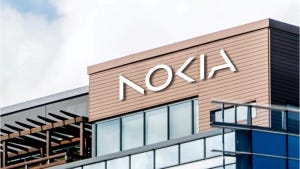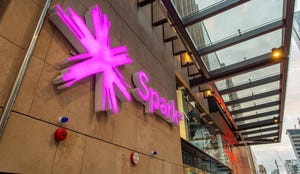Vivace Livens Up the Edge
Startup's huge, honking IP service edge switches are ready for display at Supercomm
May 20, 2002

After years of quiet, Vivace Networks will finally show off its two multiservice IP switches, the Viva5100 and the Viva1050, at Supercomm 2002 (see Vivace Delivers IP Switches).
As one of several companies hoping to help carriers turn packets into dollars, Vivace's pitch sounds familiar: "We have more ports, offer more services, so carriers make more revenues and more profits," says Ken Koenig, Vivace's chairman and CEO.
Vivace is selling its two products as edge switches, each combining the QoS (quality of service) functions of a Layer 2 switch and the packet forwarding functions of a Layer 3 router. The larger of the two, however, has the density and capacity of something you'd expect to see at the network's core.
Rather than just being combo devices, however, Vivace says its switches handle IP traffic better than an ATM switch, while still giving the carrier a way to enforce and measure QoS, unlike legacy routers. "Where we differ from a core router or an ATM switch is that our focus is provisioning Layers 1, 2, and 3 virtual private services, allowing a carrier to mix and match those on the same platform," says Mike Kazban, Vivace's VP of marketing.
Vivace's big edge box, the Viva5100, takes up one half of a 7-foot telco rack and scales to 320 Gbit/s of full-duplex switching. It can scale to handle 6,000 DS3s in a full rack and, in a multishelf setup, it maxes out at 2.5 Tbit/s. Its little brother, the Viva1050, occupies three rack units of space and provides 16 Gbit/s of port density. Both boxes use the same interface cards, and the company says both support DS3, OC3/STM1 through OC192/STM64), Gigabit Ethernet, and 10-Gigabit Ethernet interfaces. The boxes also support the Internet Engineering Task Force (IETF)'s Martini working draft of MPLS. Both products are also generally available, according to the company.
Adding some weight to Koenig's pitch is the fact that Vivace says it has already shipped its switch to a "Tier-1" carrier that has been testing the platform since last year and plans full deployment within a few months. Additionally, the company asserts, seven carriers in all have been evaluating Vivace's gear since the third quarter of 2001.
In one particular central office, Vivace says it replaced five racks of Layer 2 frame relay/ATM switches with one of its Viva5100 boxes. Its customer, like many carriers, realized that its own ATM switches were supposed to support LAN services, voice and video applications, and the like, at high speeds but couldn't scale beyond OC12.
Analysts say the traditional Asynchronous Transfer Mode (ATM) switch vendors spent so much time chasing Multiprotocol Label Switching (MPLS) that they never properly updated their older switches. Now startups such as Vivace are building bigger, faster, switches that can replace legacy ATM gear -- all because the larger vendors were focusing on the MPLS switches of the future (see MPLS is Key to Profits, Says Study).
Vivace is "supporting a carrier's traditional services, while offering them a simple migration towards packet-based switching," says Michael Ladam, a senior research analyst at Stratecast Partners. "They're also providing higher speeds for both frame relay and ATM."
Vivace's competitors include big equipment vendors such as Cisco Systems Inc. (Nasdaq: CSCO), Marconi PLC (Nasdaq/London: MONI), Alcatel SA (NYSE: ALA; Paris: CGEP:PA), and Lucent Technologies Inc. (NYSE: LU). WaveSmith Networks Inc. and Équipe Communications Corp. would rank among its startup competitors. One thing Vivace still needs to prove is that, despite the fact that it’s a startup, it can support sales to the Tier-1 carrier it is targeting. Industry analysts point to Équipe's arrangement with Ciena Corp. (Nasdaq: CIEN) as an example of how a startup could help its viability among large carriers (see Équipe Announces Third Round Funding, Partners with Ciena).
Vivace has been around since 1999 and has raised more than $120 million in venture funding from the likes of Sutter Hill Ventures, Foundation Capital, Brentwood Venture Capital, Institutional Venture Partners, Redpoint Ventures, Meritech Capital Partners, Putnam Investment Management Inc., and J.P. Morgan & Co.. Though its silence has sometimes invited scorn from outsiders, the company still maintains it has more cash in the bank than some of its competitors have raised (see Startup Trouble: Curse of the V?).
Light Reading will examine all of these offerings in more detail in the course of a Webinar running on May 30th. To register for this event, titled “Multiservice Switches: Future-Proofing the Public Network,” please click here: www.lightreading.com/webinars.asp, and scroll down.
— Phil Harvey, Senior Editor, Light Reading
http://www.lightreading.comFor more information on Supercomm 2002, please visit: SupercommSpecial
You May Also Like










